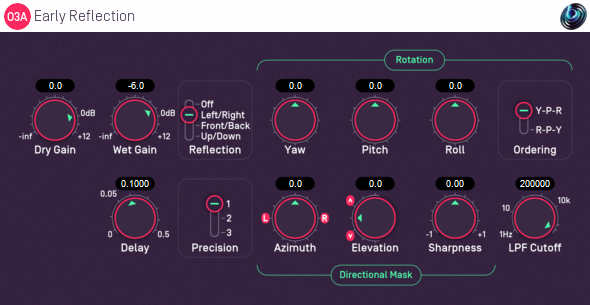O3A Early Reflection

Host Support
| Host Type | Support |
|---|---|
| AAX | Yes |
| VST2 | Yes |
Audio
| Channels | Content | |
|---|---|---|
| Input | 16 | O3A |
| Output | 16 | O3A |
Controls
- Dry Gain
- Wet Gain
- Reflection
- Pitch
- Roll
- Rotation Ordering
- Yaw
- Delay
- Precision
- Mask Azimuth
- Mask Elevation
- Mask Sharpness
- LPF Cutoff
Description
This plugin produces a single modified echo or reflection of an O3A stream.
The input may be delayed, modified and then mixed with the dry input. Modifications may include reflection and rotation, directional emphasis and low pass filtering.
A number of these reflections are used in the MS3 or MS5 reverbs, along with a late reflection model.
The plugin is available in the O3A Reverb plugin library.
Controls
Controls: Dry Gain and Wet Gain
These control how much unmodified "dry" input and modified "wet" material is included in the output.
Control: Reflection
This can be used to apply a fixed spatial reflection to the O3A material before a spatial rotation is applied. The spatial reflections available are:
- None
- Left/Right
- Front/Back
- Up/Down
Note that, by combination with the rotation, it is possible to construct any other angle of reflection.
Controls: Pitch, Roll, Rotation Ordering and Yaw
The delayed signal can be rotated. The rotation is applied after any fixed reflection.
This modification stage behaves in the same way as the O3A Rotation plugin.
These controls use angles between -180 and +180 degrees which can each be thought of as controlling individual rotations around three fixed axes. The overall rotation is a combination of the three.
| Rotation | Axis | Description of Positive Movement |
|---|---|---|
| Yaw | Z | The soundfield is "rotated" left around the middle of the room. For instance, a sound that starts at the front moves left, a sound that starts at the left moves backwards and a sound directly above does not move. |
| Pitch | Y | The soundfield is "tumbled" backwards. For instance, a sound that starts at the front moves upwards, a sound that starts at the left does not move and a sound directly above moves backwards. |
| Roll | X | The soundfield is "tilted" clockwise. For instance, a sound that starts at the front does not move, a sound that starts at the left moves upwards and a sound directly above moves right. |
The ordering control determines the order in which the yaw, pitch and roll rotations are applied to make up a single rotation. The default is Y-P-R (i.e. yaw, pitch and then roll) but this can be switched to R-P-Y (i.e. roll, pitch and then yaw).
Control: Delay
This is a delay applied to modify the signal. It is measured in seconds.
When choosing delay times, it is sometimes useful to consider the time it takes for sound to travel a distance. The speed of sound is typically around 340m/s, so it takes about 0.003 seconds (3ms) for sound to travel one metre.
Control: Precision
Precision can be reduced to save CPU and produce a less sharp image. The precision value corresponds directly to the internal ambisonic order used for processing. A value of three indicates that full third order ambisonics (O3A) will be used.
Controls: Mask Azimuth, Mask Elevation and Mask Sharpness
After reflection and rotation, the modified signal can be masked so only certain directional components are kept.
This modification stage behaves in the same way as the O3A Directional Mask plugin from the O3A Manipulator plugin library. This modifies levels in a 3D O3A mix to emphasise or de-emphasising sound in a particular direction.
Azimuth is the horizontal angle, between -180 to +180 degrees, measured anticlockwise (left) from the front. Elevation is a vertical angle between -90 and +90 degrees, measured with positive upwards and 0 on the horizontal.
For instance, the direction for azimuth +90 and elevation +45 can be found by turning 90 degrees to the left and then looking up by 45 degrees.
The sharpness control affects the sharpness and strength of the emphasis applied. A value of zero indicates that no modification should be made to the stream. Positive values leave sound in the chosen direction as it is but reduce sound elsewhere, so that the direction is emphasised. Values near +1 provide the sharpest emphasis. Negative values reduce the sound in the chosen direction, so it is de-emphasised. Values near -1 provide the sharpest de-emphasis.
Control: LPF Cutoff
This final stage of signal modification applies a first order low pass filter to the audio. This can be used to make the reflection sound more distant or muffled.
That's a lot of controls. How should I use them?
As is often the case, the O3A Visualiser will help you out. You might want to put the dry level to silent while working on the reflection.
For instance, to simulate a side reflection off a right wall, you might want to reflect the whole stage so that sounds on the left appear on the right etc. and rotate slightly for the exact wall angle. And to isolate just reflected sounds coming from the right, apply a positive directional mask on the right hand side. This will result in a reflection heard on the right which only occurs after audio events on the left.
